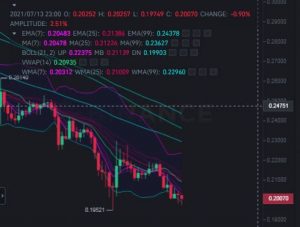US-China rare earths deal, and more DoD money will not loosen China’s grip on military-grade rare earth magnets
June 19, 2025 ( Newswire) Rare earths have been in the news lately, with a deal between the United States and China regarding the 17 elements on the Period Table, followed by a plan the Trump administration is developing to prioritize and fund rare earth projects it deems critical to national security.

According to a June 12 story by Bloomberg, Officials are discussing using the Defense Production Act to tap financing, loans and other means for rare earths element-related projects, including mining, processing and other downstream technologies to bolster the US’s capability to build a domestic supply chain, the people said. A specific course of action or a timeline have yet to be finalized, the people said.
So, at this point, we don’t know which upstream mining projects will be funded, particularly which deposits will be developed. This is important to know, because not all rare earths deposits are created equal. The light rare earth elements are the easiest to extract and separate, whereas heavy rare earths separation is complicated, expensive, and messy, creating environmental degradation unless stringent regulations are put in place.
Yet it is the heavies that are most needed for high-tech and military applications. The rare earth element samarium and the critical metal cobalt create samarium-cobalt permanent magnets that are valued for their resistance to high temperatures and corrosion.
Defense contractor Lockheed Martin is the main US consumer of samarium, with about 50 pounds of samarium-cobalt magnets in an F-35 fighter plane. The magnets retain their magnetic properties under temperatures high enough to liquefy lead. The New York Times reported the Biden administration attempted to kick-start processing of samarium in 2022, awarding financing to MP Materials and Australia’s Lynas Rare Earths. However, MP Materials told the Times that the market was too small to support producers in the US. (Investor’s Business Daily)
Executive Order 14241 directs federal agencies to streamline permitting and accelerate the development of U.S. mineral projects, while invoking the Defense Production Act (DPA) to prioritize and fund the mining and processing of critical minerals on public lands. Currently, there is no heavy rare earth separation capacity in the United States, though efforts to build this capability are underway.
Indeed, China maintains a chokehold on all aspects of rare earths production – from mining to refining/separation to the manufacture of rare earth metals needed for permanent magnets, among other final products. China mines 60% of the world’s rare earths and processes 87% of them. (Visual Capitalist)
China’s metal dominance – Richard Mills
This put the United States in a vulnerable position – if rare earths exports to the United States were to be banned or restricted, as they have been recently, the US military’s war-fighting capabilities would be severely compromised. In this article, we prove that the latest initiatives by the United States to lessen rare earths import dependence on China have in fact done little to loosen China’s grip on rare earths elements, particularly those needed to make military-grade magnets.
China-US rare earths deal
On June 11 US and Chinese officials finalized a new trade framework following two days of negotiations in London. According to the Center for Strategic & International Studies (CSIS), the agreement includes a commitment from Beijing to resume exports of rare earth elements and magnets to the United States, following two months of severe export restrictions that disrupted key inputs for the automotive, robotics, and defense sectors.
In early April, China imposed export controls on seven rare earth elements (REEs) and related permanent magnets, citing national security concerns and in response to US tariffs. The targeted REEs include samarium, gadolinium, terbium, dysprosium, lutetium, scandium and yttrium.
Although hundreds of export licenses have been submitted to Chinese authorities since April, only a quarter have been approved. The delay in issuing export licenses has had a significant impact on US, European and Japanese companies, particularly auto manufacturers.
According to CSIS, Ford shut down production of the Ford Explorer at its Chicago plant for a week in May due to a rare earth’s shortage; several European auto supplier plants and production lines were closed; Nissan and Suzuki Motors reported supply disruptions; and shipments of rare earth magnets to Germany fell 50% from March to April.
In the deal to restore US access to Chinese rare earth elements, According to reports, in exchange for China supplying the United States “up front” with rare earths and permanent magnets, the deal permits the United States to impose a 55 percent tariff on Chinese imports, consisting of a 10 percent base “reciprocal” tariff, an additional 20 percent tariff tied to fentanyl trafficking, and a 25 percent tariff that incorporates existing duties. China would apply a 10 percent tariff on U.S. imports.
Notably, China has weaponized various minerals over the past two years, including restrictions on gallium, germanium, graphite, antimony, tungsten and rare earths. In response, rare earths have been a cornerstone of the second Trump administration. For example, in a state visit to Saudi Arabia, Trump signed a memorandum of understanding between US-based MP Materials and Saudi Arabia’s Ma’aden mining company to advance a complete mine-to-magnet supply chain.
Australia will be an important ally in reducing dependence on China, for example Iluke Resources’ Eneabba Rare Earths Refinery in Western Australia, supported by a $1.25 billion government loan; and Arafura Rare Earths Limited’s Nolans Project, which has secured $840 million in federal funding and is projected to supply 4% of the global demand for neodymium and praseodymium starting in 2032. Australia is on track to triple its output of mined rare earth oxides between 2025 and 2027.
The Department of Defense (DOD), in its 2024 National Defense Industrial Strategy, set a target to establish a fully integrated mine-to-magnet rare earth supply chain capable of meeting all U.S. defense requirements by 2027. Since 2020, the DOD has invested over $439 million to strengthen domestic supply chains. This includes a $9.6 million award to MP Materials in 2020 under the DPA Title III program to develop a light rare earth separation facility at Mountain Pass, California, followed by a $35 million award in 2022 for a heavy rare earth processing facility.
CSIS notes, the only long-term solution to the rare earths crisis is to build alternative supply chains that reduce dependence on China. This will include building and expanding domestic rare earth mining, refining, and magnet manufacturing capacity for both light and heavy rare earths, as well as working with international partners to unlock new deposits and establish processing and manufacturing hubs.
Back to the June 11 agreement, while Trump wrote on his Truth Social media platform, “Our deal with China is done, subject to final approval from President Xi and me,” it does not favor the United States because China has given up so little.
Reuters reported on Sunday that The renewed U.S.-China trade truce struck in London left a key area of export restrictions tied to national security untouched…
Beijing has not committed to grant export clearance for some specialized rare-earth magnets that U.S. military suppliers need for fighter jets and missile systems, the people said.
Treasury Secretary Scott Bessent said there would be no “quid pro quo” on easing curbs on exports of AI chips to China in exchange for access to rare earths. Indeed, the United States maintains export curbs on China’s purchases of advanced artificial intelligence chips, out of concern they also have military applications.
While China promised to fast-track approval of RE export applications, the applications are from non-military US manufacturers, and the licenses only have a six-month term. In other words, the United States is not getting any rare earths from China for defense purposes, and the rare earth export licenses for civilian purposes are temporary; they have to be renewed every six months.
Importantly, Reuters states, China has not budged on specialized rare earths, including samarium, which are needed for military applications and are outside the fast-track agreed in London, the two people said. Automakers and other manufacturers largely need other rare earth magnets, including dysprosium and terbium.
The agreement reached in London then is a far cry from Trump’s Truth Social announcement last Wednesday: “FULL MAGNETS, AND ANY NECESSARY RARE EARTHS, WILL BE SUPPLIED, UP FRONT, BY CHINA.”
Investor’s Business Daily said the talks’ failure to unlock exports of rare earth magnets for specialized national security needs could become an issue for Lockheed Martin’s F-35 fighter jets as inventories run down.
A shortage of rare earths also threatens to hit the brakes on US manufacturing of cars, robotics and other high-tech gear.
DoD initiative
Soon after the London rare earths deal was announced, Bloomberg came out with this headline: ‘Trump mulls using defense powers to fund rare earth projects‘.
As mentioned the Department of Defence in 2020 awarded $9.6 million to MP Materials to develop a light rare earths separation facility at its Mountain Pass mine in California, followed by a $35 million in 2022 for a heavy rare earth processing facility.
According to Bloomberg, Officials are discussing using the Defense Production Act to tap financing, loans and other means for rare earths element-related projects, including mining, processing and other downstream technologies to bolster the US’s capability to build a domestic supply chain, the people said…
The US currently lacks the so-called mine-to-magnet capability at scale, and invoking the emergency authority will give the Defense Department and other agencies tools to speed up sourcing that severely lags China’s dominance in the industry. The urgency has only increased since Beijing flexed its rare earths capacity as leverage in trade talks with Washington over the past month.
While short on details, the article says that MP Materials, operator of Mountain Pass and the only current domestic producer of rare earths, “would be a prime beneficiary.”
MP Materials
Up until recently, MP Materials dug up predominantly light rare earth elements from Mountain Pass and sent them to China for processing – leading to accusations that the company was “owned” by China and did nothing to transform the United States from a rare earth’s miner to a rare earth’s refiner and permanent magnets producer.
In fact, the company is owned by US hedge funds JHL Capital Group and QVT Financial LP, along with its CEO, James Litinsky, who collectively hold a 51.8% stake. Shenghe Resources, a Chinese company with partial state ownership, holds an 8% stake. Shenghe was the company doing the processing; however this stopped in April 2025, when MP Materials stopped shipping rare earths concentrate to China following China’s imposition of rare earths export controls and retaliatory tariffs.
First came a milestone achieved in January of this year.
The company announced it commenced commercial production of neodymium-praseodymium (NdPr) metal and trial production of automotive-grade, sintered neodymium-iron-boron (NdFeB) magnets at its Independence facility in Fort Worth, Texas.
MP has ramped up its capacity to produce rare earth concentrate from its Mountain Pass mine, which it turns into neodymium-praseodymium (NdPr) metal magnets at Independence.
But it’s the NdFeB magnets that are important.
According to the company, they are “the world’s most powerful and efficient permanent magnets – essential components in vehicles, drones, robotics, electronics, and aerospace and defense systems.”
The Independence facility is expected to produce about 1,000 tonnes of
NdFeB magnets per year, with a gradual production ramp beginning in late 2025. The facility will supply magnets to General Motors and other manufacturers, sourcing its raw materials from Mountain Pass.
(In 2021, MP Materials entered into an agreement with General Motors to supply US-sourced and manufactured rare earth materials, alloy, and finished magnets for the electric motors used in the GMC HUMMER EV, Cadillac LYRIQ, Chevrolet Silverado EV, and more than a dozen models using GM’s Ultium Platform. Read the press release)
One thing that jumped out of me was a statistic reported by The Northern Miner. While MP Materials expects to produce 1,000 tonnes of NdFeB magnets, by contrast, China produced an estimated 300,000 tonnes of NdFeB magnets in 2024, up from 280,000 tonnes in 2023.
1,000 tonnes vs 300,000 tonnes means MP Materials only has the capacity to supply 0.003% of China’s NdFeB magnet capacity.
It’s also the kind of rare earths that Mountain Pass is producing that is important. While the open-pit mine last year produced a record-high 45,000 tonne of rare earth oxides in concentrate, and a midstream production record of about 1,300 tonnes of NdPr oxide (needed for the magnets), MP Materials produces virtually no rare earths needed for defense/ military applications. The Mountain Pass mine primarily produces neodymium-praseodymium (NdPr) oxide, a key component in NdFeB permanent magnets. Other rare earth compounds include lanthanum carbonate and cerium chloride, as well as bastnaesite concentrate and heavy rare earths concentrate. The latter, as far as I can tell, has yet to be incorporated into the Independence permanent magnet facility.
Lynas Corp
The only other non-Chinese rare earths producer is Australia’s Lynas Corp. It produces rare earths from its Mount Weld mine in Australia, then refines them in Malaysia.
Like MP Materials, Lynas is also building a rare earths processing facility in Texas. An AI Overview says the facility in Seadrift, TX will be a heavy rare earths separation plant, co-located with a light rare earth’s separation plant. It will produce dysprosium and terbium, two heavy rare earth elements crucial for high-performance magnets, particularly those used in electric vehicles and wind turbines.
The overview says these elements are added to neodymium-iron-boron magnets to enhance their heat resistance. It does not say whether these magnets are military-appropriate, nor whether the facility will manufacture samarium-cobalt magnets necessary for multiple military applications.
The plant is being supported by a $120 million contract from the US Department of Defense. It is expected to be operational in 2026.
Separation anxiety
The rare earths are a group of 17 elements comprising scandium, yttrium, and the lanthanides. The lanthanides are a group of 15 (cerium, dysprosium, erbium, europium, gadolinium, holmium, lanthanum, lutetium, neodymium, praseodymium, samarium, terbium, thorium, thulium, ytterbium) chemically similar elements with atomic numbers 57 through 71, inclusive.
The lanthanides are divided into light rare elements, LREE, and heavy rare earth elements, HREE. Light REEs are made up of the first seven elements of the lanthanide series: lanthanum (La, atomic number 57), cerium (Ce, atomic number 58), praseodymium (Pr, atomic number 59), neodymium (Nd, atomic number 60) promethium (Pm, atomic number 61) and samarium (Sm, atomic number 62).
HREEs are made up of the higher atomic numbered elements – europium (EU, atomic number 63), gadolinium (Gd, atomic number 64), terbium (TB, atomic number 65), dysprosium (Dy, atomic number 66), holmium (Ho, atomic number 67), ebium (Er, atomic number 68), thulium (Tm, atomic number 69), ytterbium (Yb, atomic number 70) and lutetium (Lu, atomic number 71).
Mining REEs is fairly straightforward but separating and extracting a single REE takes a great deal of time, effort and expertise.
- Rare earth ore: the ore is ground up using crushers and rotating grinding mills, magnetic separation (bastnasite and monazite are highly magnetic, they can be separated from non-magnetic impurities in the ore through repeated electromagnetic separation) and flotation gives you the lowest-value sellable product in the rare earth supply chain: the concentrated ore. The milling equipment – crushers, grinding mills, flotation devices, and electrostatic separators – all have to be configured in a way that suits the type of ore being mined. No two ores respond the same way.
- Concentrated ore: chemically extract the mixed rare earths from the concentrated ore (cons) by chemical processing. The cons have to undergo chemical treatment to allow further separation and upgrading of the REEs. This process, called cracking, includes techniques like roasting, salt or caustic fusion, high temperature sulfidation, and acid leaching which allow the REEs within a concentrate to be dissolved. This separates the mixed rare earths from any other metals that may be present in the ore. The result will be still-mixed-together rare earths.
- Rare earth oxide (REO): the major value in REE processing lies in the production of high-purity REOs and metals – but it isn’t easy. A REE refinery uses ion exchange and/or multi-stage solvent extraction technology to separate and purify the REEs. Solvent-extraction processes involve re-immersing processed ore into different chemical solutions to separate individual elements. The elements are so close to each other in terms of atomic weight that each of these processes involve multiple stages to complete the separation process. In some cases, it requires several hundred tanks of different solutions to separate one rare earth element. HREEs are the hardest, most time-consuming to separate.

Source: Security Beat
Permanent magnets primer
MP Materials’ Fort Worth facility is where refined rare earth materials from its Mountain Pass mine in California are transformed into metals, alloys, and finished neodymium-iron-boron (NdFeB) magnets.
NdFeB magnets, or just neodymium magnets, are critical for electric vehicles, robots and wind turbines. One magnet manufacturer names their top 8 uses: MRIs, magnotherapy, audio equipment, lifting large loads, permanent magnet motors, magnetic separation technology, microwave communication technology, and magnetization technology.
They are also used in defense applications. A paper titled ‘America’s Dependence On and Need to Secure Its Supply of Permanent Magnets’ by USAF Lieutenant Colonel Justin Davey states that “Neodymium and samarium… have a disproportionate influence on all high technology businesses, especially the defense industry.
They combine with other elements (specifically iron, boron, and cobalt) to make exceptional permanent magnets. Samarium-cobalt (SmCo) magnets have the highest known resistance to demagnetization. This capability, meaning the magnet has higher coercivity, allows them to function in high-temperature environments without losing magnetic strength – an essential attribute for most military applications.
Similarly, neodymiumiron-boron (NdFeB) magnets are incredibly strong – the most powerful commercial magnet available. Compared to an equal mass of traditional ferrite magnet, an NdFeB magnet has over 10 times the magnetic energy product. Accordingly, a much smaller amount of magnet is required for any particular application. This attribute makes them ideal for miniaturization of motors, electronics, and electrical components.”
Samarium-cobalt magnets were first introduced in the 1970s. They are stronger than alnico or ceramic material and offer the best heat resistance of all the permanent magnet types, with the ability to withstand temperatures up to 300 degrees C. However, due to their higher cost, they are less popular than the most common rare earth magnet, NdFeB. Samarium-cobalt magnets are highly resistant to rusting, but they are also brittle and may fracture when extreme heat causes them to expand.
Neodymium-iron-boron magnets have similar properties to their samarium-cobalt cousins, except they are less resistant to oxidation, needing a surface treatment, and can’t withstand such high temperatures. Because they pack such a high magnetic punch, NdFeB magnets can fit into compact spaces, such as electric motors and cordless tools.
Terbium and dysprosium are sometimes added to NdFeB magnets to allow them to tolerate even higher temperatures.
“Miniature high-temperature resistant permanent magnets are a key factor in developing state-of-the-art military technology,” Lieutenant Colonel Davey’s paper continues. “They pervade the equipment and function of all service branches, starting with commercial computer hard drives containing NdFeB magnets that sit on nearly every Department of Defense (DOD) employee’s desk.
“Precision-guided munitions depend on SmCo magnets as part of the motors that manipulate their flight control surfaces. Without these advanced tiny magnets, the motors in “smart bombs,” like the joint direct attack munition (JDAM), would require a hydraulic system that is more expensive and three times as large.
The generators that produce power for aircraft electrical systems also rely on samarium-cobalt magnets, as does the stealth technology used to mask the sound of helicopter rotor blades by generating white-noise concealment. Other permanent magnet applications include “jet engines and other aircraft components, electronic countermeasures, underwater mine detection, antimissile defense, range finding, and space-based satellite power and communications systems,” according to USGS.
The Army relies on REE magnets for the navigation systems in its M1A2 Abrams battle tank and the Navy is developing a similarly dependent electric drive to conserve fuel for its Arleigh Burke-class destroyers. The Air Force’s F-22 fighter uses miniaturized permanent magnet motors to run its tail fins and rudder.”
According to the US Department of Defense, Rare earth permanent magnets are not only essential components in a range of defense capabilities, including the F-35 Lightning II aircraft, Virginia and Columbia class submarines and unmanned aerial vehicles, but also a critical part of commercial applications in the United States. They are also used to generate electricity for electronic systems in aircraft and focus microwave energy in radar systems.
Since 2020, DOD has awarded more than $439 million to establish domestic rare earth element supply chains. This includes separating and refining rare earth elements mined in the U.S., as well as developing downstream stateside processes needed to convert those refined materials into metals and then magnets.
In addition to the F-35, Virginia and Columbia class submarines, magnets produced from rare earth elements are used in systems such as Tomahawk missiles, a variety of radar systems, Predator unmanned aerial vehicles, and the Joint Direct Attack Munition series of smart bombs. The F-35, for instance, requires more than 900 pounds of rare earth elements. Each Arleigh Burke DDG-51 destroyer requires 5,200 pounds, and a Virginia class submarine needs 9,200 pounds.
Anti-ballistic missiles like Israel’s “Iron Dome” use samarium-cobalt and neodymium magnets for various functions within the missile’s guidance and control systems. It was recently reported that Israel and the United States are using ballistic missile interceptors at a rapid clip after four days with Iran. There are even concerns that a direct US strike on Iran could lead to bigger Iranian retaliation against Israel that would drain the US’s global stockpile of missile interceptors to a “horrendous” level, one US official said.
Other military applications
Rare earths are central to the whole spectrum of defense technologies that are vital to every military. Without them, countries would be unable to produce much of the military hardware and equipment required for national defense. In most case there are no substitutes. Moreover, switching from current suppliers (i.e. China) would cause major disruptions to supply chains. According to the US Government Accountability Office, it would take 15 years to overhaul the defence supply chain, meaning any changes to it need considerable lead time.
Apart from permanent magnets, of which the US military is an important buyer, other applications of rare earth elements include:
- Radar and sonar used to prevent collisions, for surveillance and navigational aids. The Patriot Missile Air Defense System employs radio frequency circulators to magnetically control the flow of electronic signals in the radar and missiles. Rare earths required: gadolinium, samarium, yttrium.
- Communications and displays required by soldiers, sailors and airmen to see analog and digital data. Examples are lasers that help line-of-sight communication links in satellite and ground-based systems; old and new computer monitors; and avionics terminals. Rare earths required: dysprosium, erbium, europium, neodymium, praseodymium, terbium and yttrium.
- Lasers employed on vehicle-mounted systems like tanks and armored vehicles. They can identify enemy targets up to 22 miles. According to DefenseMediaNetwork, “The laser-equipped computer main gun sight on the Abrams M1A/2 tank combines a Raytheon rangefinder and integrated designator targeting system used to obtain a high-probability first hit.” Rare earths required: europium, neodymium, terbium and yttrium.
- Precision-guided munitions (PGMs) take in a number of missile classes including cruise, anti-ship (ASM) and surface-to-air (SAM), as well as bunker busters. The heat-seeking AIM-9 Sidewinder missile has four fins on its fuselage that use rare-earth magnets to control its flight trajectory. Rare earths required: dysprosium, neodymium, praseodymium, samarium and terbium.
- Guidance and control systems that steer missiles and bombs towards their targets. Rare earths required: terbium, dysprosium, samarium, praseodymium and neodymium.
- Electronic warfare refers to a range of equipment that includes high-capacity power sources, storage batteries and electronic jamming devices. Rare earths required: yttrium-iron-garnet.
- Jet engines. The rare earth element erbium is added to vanadium to make it more malleable for use in vanadium-infused steel that goes into jet engines. While not specifically a rare earth element, the rare element rhenium is alloyed with molybdenum and tungsten. The F-22 Raptor and the F-35 Lightning II stealth fighter reportedly use 6% rhenium in their engines. The electrical systems in aircraft employ samarium-cobalt permanent magnets to generate power.
Not enough
According to the US Geological Survey, MP Materials produces a rare earth concentrate that annually contributes around 15% of the rare earth minerals consumed each year.
MP Materials is focused on refining a compound of neodymium and praseodymium – one of the most common materials used to make rare earth magnets – as well as lanthanum and cerium. These elements are classified as “light rare earths.”
The US government clearly wants MP Materials to also produce heavy rare earths concentrates that it can use to make specialty magnets, especially samarium-cobalt magnets. The DoD awarded MP Materials a $35 million contract in 2022 to build a facility to process heavy REEs. A 2023 article by National Defense Magazine says the heavy rare earths will be refined in a different building than the lights, and that the project is just getting started.
The article notes that heavy rare earths terbium and dysprosium are needed to make rare earth permanent magnets that can operate in high temperatures, while samarium is used to produce samarium-cobalt magnets found in aerospace and defense applications.
As I said earlier, I don’t see anything at the Independence facility in Texas to indicate that HREEs are being turned into magnets. Yet.
Rare earths expert Jack Lifton provides some perspective on the US military’s rare earths gap. He starts with the observation that a permanent magnet production facility currently under construction in South Carolina would produce 2,000 tonnes annually, of which 1,200 tonnes is earmarked for current military demand.
But Lifton isn’t optimistic about the ability of US companies to develop this industry:
The few U.S.-based companies vying to establish themselves as domestic sources of rare earth permanent magnets for private industry possess aspirations, not achievements. They lack the capacity to produce at scale, the technical experience to compete globally, and the balance sheets to operate without subsidy…
Collectively, the U.S. and European consumer sectors represent a modest portion of global demand for rare earth permanent magnets-approximately 40,000 tonnes annually spread across more than 30 nations. This figure amounts to just 10% of China’s installed production capacity. China itself consumes an estimated 80% of what it produces, underscoring both the scale and self-sufficiency of its domestic industry.
Can the rest of the world construct a rare earth permanent magnet industry capable of global cost-competitiveness with China? No. Can select non-Chinese firms develop limited-scale, financially sustainable magnet production capacity for strategic or niche markets? Possibly.
Mark Smith, the former boss of Molycorp, which ran the Mountain Pass mine before it went bankrupt and was bought by MP Materials, says Western nations will take years to develop enough rare earth processing capacity to limit China’s dominance over them. The current CEO of NioCorp Developments is developing a new mine in Nebraska that could produce rare earth elements, but notes that even with approved mines, production would start in 2029 at the earliest.
No firm outside of China can yet produce significant quantities of the terbium, dysprosium or samarium limited by Beijing and necessary for magnets to endure high operating temperatures. (Bloomberg)
Clyde Russell, a metals columnist with Reuters, thinks the US-China deal on rare earths will probably hurt both economies due to the high tariffs now in place (55% on Chinese imports, 10% on US imports). Moreover, Russell believes the deal does little to solve the underlying problem with rare earths, magnets and other refined metals such as lithium and cobalt, which are dominated by Chinese supply chains:
At best, the agreement this week is a kick the can down the road type of deal, insofar as it prevents an immediate crisis in manufacturing in the United States but leaves open the possibility that Beijing will once again threaten supplies if there are problems between the two sides in the future.
The Guardian notes that China has a stranglehold on the production and export of samarium, which, as explained above, is needed to make samarium-cobalt magnets used to withstand the intense temperatures in military-grade technology. Examples include guided missiles, satellite-guided smart bombs and fighter jets, but the Guardian says supplies of those weapons have been depleted through deliveries of missiles and other ordnances to Ukraine and Israel.
China controls 100% of world samarium supply. There is also no commercial production of dysprosium and terbium outside of China. High-performance NdFeB magnets require trace amounts of these rare earths to function at high temperatures.
Stanford Magnets concurs that consumption of rare earths in the United States, including rare earth magnets, is highly dependent on China. More than 90% of the world’s rare earth permanent magnet supply comes from China, and the United States also needs to import nearly 70% of rare earth magnets from China.
At present, the United States does not have enough R&D capabilities to manufacture rare earth permanent magnets. For example, the United States does not have the ability to produce high-temperature and corrosion-resistant samarium-cobalt rare earth permanent magnets, which can be used to make rare-earth permanent magnets for precision-guided missiles, smart bombs, and military aircraft. However, China has this technology.
At present, China’s rare earth processing capacity is five times the total rare earth processing capacity of other regions in the world. This means that it will take at least a few years to build a processing plant that can match China’s rare earth production capacity.
Remember, MP Materials’ plant in Texas can produce 1,000 tonnes of neodymium magnets per year. China produces an annual 300,000t.
MP Materials and Lynas may have the capability of producing rare-earth materials that are necessary for making military-grade magnets, but the amounts are so small as to barely make a dent in China’s overwhelming global advantage.
A dated (2013) report indicated the US military needed about 1,000 tons of permanent magnets annually, but current demand is likely higher, with some estimates suggesting 3,000 tons – about triple what MP Materials is currently capable of producing.
Lynas’ Texas plant is scheduled to start up next year but again the amounts are small. According to Fastmarkets, Lynas’s facility will have estimated production capacity of 1,000-1,300 tonnes per year of light rare earth NdPr oxide, and 2,500-3,000 tpy of heavy rare earth oxides.
The company announced a year ago it plans to start producing separated heavy rare earth products at its light rare earth’s refinery in Kuantan, Malaysia. The estimated throughput capacity is 1,500 tonnes per year of a mixed heavy rare earth compound called SEGH (samarium, europium, gadolinium, holmium).
The US Department of Defense recognizes the problem and has spent $439 million since 2020 in contracts to establish domestic rare earth supply chains. Yet according to a 2024 report by the Government Accountability Office (GAO), “Critical materials such as rare earths, are materials needed to supply U.S. military, industry, and essential civilian needs during a national emergency and are not found or produced in sufficient quantities in the U.S. Rare earths and certain other critical materials, such as tantalum and tungsten, are overwhelmingly mined and processed abroad, making the U.S. reliant on foreign suppliers – particularly China.”
The GAO also pointed out, “Although the U.S. has some domestic resources and mining capability for rare earths, United States Geological Survey (USGS) identified in its 2024 Mineral Commodity Summaries report that the U.S. imported more than 95 percent of the total rare earths that it consumed. USGS’s report also noted that, from 2019 through 2022, most of the total rare earths imported into the U.S. came from China, leaving DoD weapon systems vulnerable to supply chain disruptions by an adversarial nation.” (Cipher Brief)
A last opinion by New Security Beat notes that China built an entire ecosystem around the rare earths, from mineral production and processing to manufacturing finished products, and most importantly, rare earth magnets.
The country has an effective monopoly over processing heavy rare earths dysprosium and terbium, and light rare earths neodymium and praseodymium.
China has mastered this process, while Western companies lack the expertise to achieve similar results. The two biggest rare earth mining companies outside of China, MP Materials and Lynas, have struggled to expand refining capacity despite huge US government investments.
Conclusion
Let’s go back to something Jack Lifton, the rare earths expert, wrote:
Collectively, the U.S. and European consumer sectors represent a modest portion of global demand for rare earth permanent magnets-approximately 40,000 tonnes annually spread across more than 30 nations. This figure amounts to just 10% of China’s installed production capacity. China itself consumes an estimated 80% of what it produces, underscoring both the scale and self-sufficiency of its domestic industry.
Note: these civilian-use magnets are made from light rare earths.
Samarium, terbium and dysprosium, the heavy rare earths required to build military-grade, temperature-resistant magnets, are still not commercially available outside China.
MP Materials is the only non-Chinese company currently able to complete the rare earths supply chain loop – from mining to separation/ refining to making the metal used to make permanent magnets. But MP only has the capacity to make 1,000 tonnes of neodymium magnets per year, against China’s 300,000 tpy.
The US military requires about 3,000 tons of permanent magnets a year. MP is clearly not producing enough heavy rare earths elements to meet the US military’s needs. The actual amount of HREEs required is likely classified, but in a best-case scenario, MP will make 1,000 tonnes of neodymium magnets a year – some of which will have a military use, but many will not because they lack the addition of dysprosium and terbium needed to make the magnets high temperature-resistant.
Granted, MP Materials is working on expanding its processing capabilities, including a heavy rare earth separation facility in Texas, but it still faces challenges in scaling up production to meet the military’s requirements.
When Lynas’s plant come online next year it could make 1,000-1,300 tonnes per year of light rare earth NdPr oxide, and 2,500-3,000 tpy of heavy rare earth oxides. But there is nothing to indicate that Lynas’s facility will make permanent magnets. What will Lynas do with the oxides it refines? They will likely be shipped to China for turning into military and civilian-use rare earths magnets.
The bottom line? America’s efforts to wrench control of the rare earths supply chain have so far failed despite the expenditure of nearly half a billion US dollars. In a way this is no surprise. China has had a multi-decade lead over the US rare earths mining, refining and permanent magnet manufacturing.
In another way it’s no different from the crisis America is facing regarding its lack of graphite production. Graphite is a necessary component of lithium-ion batteries; it’s used in the anode.
A report last year from the Hague Centre for Strategic Studies found that natural graphite and aluminium are the materials most commonly used across military applications and are also subject to considerable supply security risks that stem from the lack of suppliers’ diversification and the instability associated with supplying countries.
The report assessed the degree of criticality for each of 40 materials deemed critical or soon to be critical. Natural graphite was rated “very high-risk” for air applications, and “high-risk” for sea applications.
In the table below, natural graphite is rated red, very high risk, for its use in fighter aircraft, main battle tanks, submarines, corvettes, artillery and ammunition. Aluminum, used in fighters, tanks, missiles, submarines, corvettes, artillery, ammunition and torpedo’s, was also rated a very high-risk material.
>
Source: Hague Centre for Strategic Studies
The report says aluminum and natural graphite are the two most used materials in the defence industry and can be found in aircrafts (fighter, transport, maritime patrol, and unmanned), helicopters (combat and multi-role), aircraft and helicopter carriers, amphibious assault ships, corvettes, offshore patrol vessels, frigates, submarines, tanks, infantry fighter vehicles, artillery, and missiles. These materials are used in components such as airframe and propulsion systems of helicopters and aircrafts as well as onboard electronics of aircraft carriers, corvettes, submarines, tanks, and infantry fighter vehicles. The impact of supply security disruption would hence be very significant, given the multiplicity of aluminum and natural graphite’s applications.
In the fighter plane graphic below, notice the use of natural graphite (red dots) in almost every part of the plane, including the body, wings, tail, nose, nozzle, propulsion system, landing gear, electro-optical systems, and sensors and electronic systems.
According to the report, the most used of the 40 materials across the air domain are aluminum, natural graphite, copper and titanium:
These materials have several applications in aeronautics. In aircrafts (fighter, transport, maritime patrol, and unmanned) and helicopters (combat and multi-role), aluminium, natural graphite, and titanium find their main application in the airframe, where they are used in the body, wings, tail, nose, and axis of the aircraft. They are also employed in the production of propulsion systems’ components such as combustors, nozzle, drive shaft, and propellers, as well as in landing gears, connectors, and electronic systems.

Source: Hague Centre for Strategic Studies
A second graphic of a tank shows natural graphite in the inertial navigation system, combat identification equipment, and coaxial machine gun.
According to the report, For the construction of tank guns, Howitzer machine guns in infantry fighter vehicles, and GPS/SAL guidance systems in ammunition, natural graphite is found in combination with other materials to construct these components.

Source: Hague Centre for Strategic Studies
Graphite’s war-fighting capabilities – Richard Mills
China is by far the biggest graphite producer at about 80% of global production. It also controls almost all graphite processing, establishing itself as a dominant player in every stage of the supply chain.
Deficits are expected to kick in by 2025 as new graphite mines fail to keep up with surging demand from automakers. According to Benchmark Mineral Intelligence, as many as 97 average-sized graphite mines need to come online by 2035 to meet global demand. That’s about eight new mines a year, which at first may seem doable but considering the number of graphite projects worldwide and the time it takes to develop them into mines, we’re really up against it.
The US is heavily reliant on imports for graphite. In 2024, the US imported 60,000 tonnes of natural graphite, with 87.7% being flake and high purity.
The US military could not function without graphite and the US currently does not produce any graphite from domestic mines.
Aluminum, also crucial for military equipment, is fast becoming a problem to source. Earlier this month, the Trump administration doubled tariffs on steel and aluminum imports to 50%. The tariffs make it more difficult for American firms to buy imported aluminum that is turned into US military equipment.
Only one US mine, Mountain Pass in California, mines and processes rare earth elements. But most of what Mountain Pass produces are light rare earths – easier to process than heavies but not as valuable to the US military. The United States currently imports nearly all its military-grade samarium-cobalt magnets from China, a fact that I don’t see changing any time soon.
Despite the US-China rare earths agreement, despite what MP Materials is doing, despite what Lynas is doing, and despite more handouts from the Department of Defense, China is still hamstringing the US military. We could soon feel the effects of China’s rare earth restrictions on F-35 inventories, and on depleted US and Israeli anti-ballistic missiles. The automobile industry is shutting down production lines because it can’t get the rare earths. China makes the specialty magnets required, and it’s unwilling to share them.
In a 2024 column in Real Clear Energy, Eastern New Mexico University professor JimConstantopoulos writes that, should a conflict escalate into a war, the US would have shortfalls in 69 minerals, most of them used in weapons production.
In a world that is getting more dangerous by the day, with missiles being flung between Israel and Iran, and war still raging between Russia and Ukraine, that is one scary thought.
Richard (Rick) Mills
subscribe to my free newsletter
Legal Notice / Disclaimer
Ahead of the Herd newsletter, , hereafter known as AOTH.
Please read the entire Disclaimer carefully before you use this website or read the newsletter. If you do not agree to all the AOTH/Richard Mills Disclaimer, do not access/read this website/newsletter/article, or any of its pages. By reading/using this AOTH/Richard Mills website/newsletter/article, and whether you actually read this Disclaimer, you are deemed to have accepted it.
Any AOTH/Richard Mills document is not, and should not be, construed as an offer to sell or the solicitation of an offer to purchase or subscribe for any investment.
AOTH/Richard Mills has based this document on information obtained from sources he believes to be reliable, but which has not been independently verified.
AOTH/Richard Mills makes no guarantee, representation or warranty and accepts no responsibility or liability as to its accuracy or completeness.
Expressions of opinion are those of AOTH/Richard Mills only and are subject to change without notice.
AOTH/Richard Mills assumes no warranty, liability or guarantee for the current relevance, correctness or completeness of any information provided within this Report and will not be held liable for the consequence of reliance upon any opinion or statement contained herein or any omission.
Furthermore, AOTH/Richard Mills assumes no liability for any direct or indirect loss or damage for lost profit, which you may incur as a result of the use and existence of the information provided within this AOTH/Richard Mills Report.
You agree that by reading AOTH/Richard Mills articles, you are acting at your OWN RISK. In no event should AOTH/Richard Mills liable for any direct or indirect trading losses caused by any information contained in AOTH/Richard Mills articles. Information in AOTH/Richard Mills articles is not an offer to sell or a solicitation of an offer to buy any security. AOTH/Richard Mills is not suggesting the transacting of any financial instruments.
Our publications are not a recommendation to buy or sell a security – no information posted on this site is to be considered investment advice or a recommendation to do anything involving finance or money aside from performing your own due diligence and consulting with your personal registered broker/financial advisor. AOTH/Richard Mills recommends that before investing in any securities, you consult with a professional financial planner or advisor, and that you should conduct a complete and independent investigation before investing in any security after prudent consideration of all pertinent risks. Ahead of the Herd is not a registered broker, dealer, analyst, or advisor. We hold no investment licenses and may not sell, offer to sell, or offer to buy any security.
More Info:
Disclaimer/Disclosure: is a digital publisher of third party sourced news, articles and equity research as well as creates original content, including video, interviews and articles. Original content created by investorideas is protected by copyright laws other than syndication rights. Our site does not make recommendations for purchases or sale of stocks, services or products. Nothing on our sites should be construed as an offer or solicitation to buy or sell products or securities. All investing involves risk and possible losses. This site is currently compensated for news publication and distribution, social media and marketing, content creation and more. Disclosure is posted for each compensated news release, content published /created if required but otherwise the news was not compensated for and was published for the sole interest of our readers and followers. Contact management and IR of each company directly regarding specific questions.
More disclaimer info: https://www./About/Disclaimer.asp Learn more about publishing your news release and our other news services on the newswire https://www./News-Upload/
Global investors must adhere to regulations of each country. Please read privacy policy: https://www./About/Private_Policy.asp














Post Comment